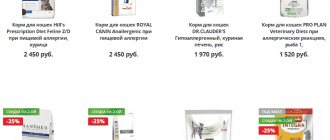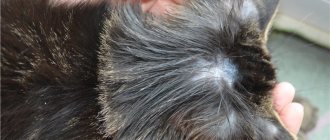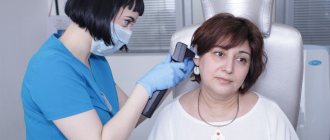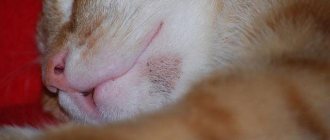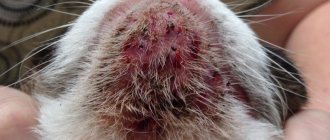What will you learn from the article?
- Skin diseases of cats - types and list
- Skin diseases in cats - symptoms and treatment Flea infestation
- Fungal infections: trichophytosis, microsporia
- Tick-borne infections
- Bacterial infections
- Allergic reactions
Skin diseases in cats are one of the most common problems that both veterinarians and owners of furry and hairless pets have to deal with. Cats who visit the street from time to time are most at risk of getting skin diseases. Animals that permanently live in an apartment are also not immune from them.
Despite their prevalence, skin diseases in cats require serious long-term treatment, many of them can lead to serious consequences and seriously undermine the health and immunity of the animal. And some pose a danger to human health.
Therefore, at the first signs of pathology, the cat must be shown to a veterinarian. Only a doctor can make a correct diagnosis and prescribe an effective treatment for skin diseases in cats that is safe for the pet and the owner.
Sores under a cat's fur: Symptoms
It can be difficult to notice any changes in the skin under a cat's fur, especially if it is thick and long. Groom your pet regularly - comb it. Then it will be easier to detect the problem at an early stage.
The owner may notice itching. Also, at the site of damage, the fur may fall off in shreds along with the crust. The skin may be red and have an unpleasant odor.
Seborrhea (dandruff) often occurs. You need to pay attention to all these signs and contact a veterinary dermatologist for diagnosis.
Watch the video: Fleas in cats - How to get rid of them, what medications to buy
History taking
Diagnostics will help you understand why your cat scratches its neck and what caused the sores. But before carrying it out, the veterinarian needs to collect an anamnesis.
Age and breed
A kitten up to one year old is susceptible to skin and subcutaneous parasites. Young animals suffer predominantly from allergic reactions. If an elderly cat scratches its neck until it bleeds and hurts, this may be due to autoimmune dermatoses.
The breed of the animal also leaves its mark. Persian cats are prone to dermatophytosis and dermatitis, while Sphynx cats are prone to allergies and neoplasms.
Lifestyle
A large number of animals in one area, access to the street, participation in cat shows and other factors increase the risk of infection with parasites and viral diseases.
Seasonality
Allergies to pollen, bee or mosquito bites have a pronounced seasonality. Flea dermatitis in cats manifests itself regardless of the time of year. But it is most common in August-September.
The cat has sores under its fur: Causes
More often, sores appear on the skin due to itching. The cat scratches itself until wounds form that become crusty.
The causes of sores can be different:
- Infestation with parasites . For example, fleas or scabies mites. The most common scabies mites are cheyletella, notoedros and demodex. If demodicosis is detected in a cat, then this is a reason to conduct additional research - to exclude immunosuppressive conditions caused by oncology, endocrinopathies
- Autoimmune diseases . In this situation, the lesions are often symmetrical.
- Endocrine pathologies . Uncommon, but they cause itching and secondary infection.
- Paraneoplastic syndrome . Lesions of the pancreas and liver. An extremely rare pathology. Do not mistakenly consider any disease of the hepatobiliary system to be the cause of itching and damage to the skin.
- Pyoderma . This is an infectious inflammation of the skin. It can be both a primary and secondary cause of lesions. Most often, overgrowth of Malassezia fungi and coccal microflora is recorded. It is worth noting that bacteria and yeast-like fungi are a normal phenomenon on the surface of the skin, it is important to understand the quantity, for this a cytological examination of the skin is performed, we will talk about it later.
- Ringworm . It can also cause baldness. It most often affects young, old and immunocompromised cats.
- Injuries . For example, caused by other cats. Their claws and teeth leave pinpoint wounds that become crusty, and underneath there is active purulent inflammation. The cat may feel unwell, lethargic, or hot due to the increase in temperature.
- Local reaction to drugs . Wounds often appear at the base of the neck or on the withers after applying drops against parasites or during subcutaneous administration of drugs. Unfortunately, this is impossible to predict.
- Food allergy . Intolerance to food components.
- Reaction to environmental allergens.
Diseases with skin lesions
It is worth taking a closer look at the health problems that cause the uncharacteristic appearance of the skin and coat. Each illness negatively affects the external and internal condition of the pet.
Bacterial and fungal infections
Infections with pathogenic organisms occur in different ways. For example, the dry type of infection causes the appearance of dry, compacted crusts on the surface of the body. The wet form is characterized by redness, ulcers, scratching and severe itching. The reasons for the penetration of infections are varied:
- metabolic disorder;
- diabetes;
- neoplasms of various types;
- weakened immune system;
- superficial wounds.
Treatment is carried out only by a veterinarian after a thorough examination and laboratory tests. One of the most unpleasant and contagious lesions is lichen, which is transmitted to other animals and humans.
It is impossible to choose on your own how to treat a cat’s scratching: to do this, you need to determine the type of pathogen. This can only be done in a veterinary clinic laboratory.
Parasites in cats
One of the most common causes of wounds on a pet’s body is parasites that choose warm areas on its surface. For example, the neck and axillary parts are very attractive to them. Parasites are external blood-sucking pests - fleas or mites, including scabies).
It is not the fleas themselves that cause discomfort, but the products of their activity. The saliva released when a wound is bitten contributes to the onset of allergic irritations. The pet scratches in this area due to severe itching. This is how pathogenic microorganisms appear in the wound, which trigger complications of the disease.
Skin pests are easy to spot. To do this, you just need to examine the body and head of your mustachioed friend. If parasites appear, it is necessary to carry out timely treatment to stop the spread of the infection. In any case, it is important to consult a veterinarian. He will examine the patient and determine that the appearance of sores in the cat is indeed associated with bloodsuckers.
Ticks are much more difficult to see. Subcutaneous individuals are found only by a doctor after a thorough examination and special tests. Treatment is most often prescribed in the form of drops on the withers or tablets. The drug "Ivermek", which is used as intramuscular injections, has proven itself well. The course of injections is 30 days, during which 3 vaccinations are given with a medicinal solution.
A similar product can also be purchased in the form of an ointment or gel. It is applied to the damaged surface after consultation with a veterinarian. Do this at home strictly according to the instructions.
It is important to remember that fleas do not pose a direct threat to your pet's health, but scabies can lead to death. Ticks not only spread under the skin, but also parasitize internal organs, so it is important to start treatment as soon as possible.
Allergic manifestations in cats
Sometimes sores on a cat’s skin occur due to allergies to external irritants. For example, purchasing a new brand of industrial food can lead to malfunctions in the body, which will manifest itself in the form of skin pathologies. It is possible to determine the cause of such a reaction by visual inspection and conducting special tests to recognize the allergen.
In addition to food, the body can react to dust, chemicals or hygiene products. Even inhaling ordinary washing powder leads to unpleasant consequences. There are times when sensitive cats react to blooms. The test, performed in a hospital setting, will identify a group of foods or other substances that need to be removed from the pet. If this is not done, the cat will have to be constantly given medications.
Dermatitis in animals
There are different types of skin dermatitis. Some of them have no complications, while others lead to death if treatment is delayed. They can be both bacterial and fungal, and are also caused by mechanical damage.
The bacterial type of dermatitis manifests itself as ulcers on the body and head of the pet. Animals with weakened immune systems, as well as babies under 1 year old, are at risk of getting sick. Once the pathogen is identified, the doctor prescribes antibiotics.
Less dangerous, but just as unpleasant, are dermatitis caused by seborrhea or injury. In the first case, the cat develops dandruff, and the animal begins to constantly itch in different places. In the second case, a simple wound can fester and cause sepsis, which in many cases leads to death.
Acne on a cat's body
Acne is blackheads with hard crusts. Acne with the appearance of open and closed comedones is usually localized on the neck, chin and lips of the cat. The cause of acne is considered to be poor hygiene, infections, stress, and abnormalities in the sebaceous glands and hair follicles. Even low-quality plastic from which the bowl is made can cause acne. Contact with cheap material can cause unpleasant rashes - it all depends on the sensitivity of the individual.
Another symptom is slight hair loss. If the disease is not treated, ulcers, purulent pimples, inflammation, and bacterial infections appear. After making a diagnosis, the veterinarian prescribes antiseptic detergents: medicated shampoo, soap. In addition, lips, chin and other areas affected by acne are treated with Miramistin or Chlorhexidine.
Other lesions
Even psychogenic factors cause ulcers and crusts on a pet’s body. For example, Cushing's syndrome is manifested by baldness of certain areas of the skin. Fortunately, this syndrome is rare in pets: it appears due to too much of the hormone cortisol. The disease has other pronounced symptoms:
- strong thirst;
- frequent urination;
- constant feeling of hunger with subsequent enlargement of the abdomen;
- lethargy, muscle atrophy;
- thin skin, baldness.
Doctors often prescribe medications that can suppress large releases of cortisol into the blood. In severe cases, the pituitary gland, adrenal gland are surgically removed, or chemotherapy is used.
Another skin problem is alopecia. Loss of fur also occurs under the influence of neuroses. They can be caused by a change of place of residence, the appearance of a new owner, or meeting a new family member. Some breeds are most prone to pathology: these are Abyssinian, Himalayan and Siamese cats.
Baldness is focal. Most often it appears on the abdomen, groin area, sides or inner thighs. Sores rarely appear on a cat's neck. The medications Kot Bayun, Amitriptyline, and Stop-Stress help to cope with the problem.
A cat has lump-shaped sores under its fur: Diagnosis
There is no single test that can be used to immediately make an accurate diagnosis. In some situations, it is even necessary to prescribe empirical treatment.
But first, a cat with sores on its fur will need to undergo tests:
- Exclusion of dermatophytes (lichen) using a Wood's lamp . Instant results, but not all types of mushrooms glow characteristically. Some types of local solutions and ointments can also distort the picture. Do not treat your cat with anything before seeing a doctor.
- A test for detecting flea feces, it is also sometimes called wet or wet. You can do it yourself at home. The cat must be actively scratched with your hand or a brush over a sheet of white, damp paper. If you find black dots, you should try to smear them. If reddish-brown stains are detected, a diagnosis of aphanipterosis-flea infestation can be made.
- Microscopic examination of deep and superficial layers of skin. To collect the material, the veterinarian will slightly scrape the skin using a blunt scalpel and transfer the particles to a glass slide. The procedure is unpleasant for the cat, but not too painful.
- Cytological examination. If the skin is dry and without damage, but only with a hairless area, then it will not be performed. When there is a scab (crust), it is lifted and a smear-imprint is made. The tape test is also used for dry damage. Next, the material is stained and the cellular composition is assessed.
- In some cases, additional research methods will be required: ultrasound, blood, feces, urine, skin histology, intradermal allergy tests, exclusion diet.
Click on the picture to enlarge
Skin diseases of cats - types and list
By their nature, they are divided into parasitic and non-parasitic diseases. In addition, it is on the skin of cats that allergic reactions most often occur.
- Parasitic infections:
1.1. Flea infestation;
1.2. Fungal infections;
- Trichophytosis;
- Microsporia.
1.3. Tick-borne infections:
- scabies;
- notoedrosis;
- demodicosis;
- sarcoptic mange;
- otodectosis;
- cheyletiosis.
- Bacterial infections:
2.1. Eczema;
2.2. Acne;
2.3. Bedsores.
- Allergic reactions:
3.1. Feed intolerance;
3.2. Atopic dermatitis;
3.3. Miliary dermatitis.
The cat has sores under its fur: Is the danger high?
The greatest danger comes from traumatic skin injuries. With the development of diffuse inflammation (phlegmon) or a more local abscess, sepsis can develop, which can lead to the death of the cat.
But in most cases, everything is not so scary, all dermatological diseases can be treated, although the time frame may be different. In the case of autoimmune diseases, lifelong medication is required.
Also, some causes of skin damage in cats can be contagious to other animals and people.
Blackness in a cat's ears: What is it and how to treat it? – https://strazhchistoty.ru/cleanup/cleancats/chernota-u-koshki-v-ushah.html
If all else fails
The most difficult moment for a loving owner is when he tries different methods one after another, but nothing works. The cat has a sore on her neck, a blood scab, which is also beginning to rot. Until you find the cause, you need to fight at least the effect so as not to trigger the disease. In this case, it is best to choose Terramycin or Amidel spray. They help dry wounds very well and relieve inflammation. But the effect will be temporary, since we have not yet eliminated the cause. However, it is important not to make the situation worse with sepsis, so continue to look for treatment options and in the meantime, keep using the spray or ointment.
Sores under the fur of a cat's neck. What is contagious to people and other animals
- Lichen (dermatophytosis) . The most common disease, which, fortunately, can be quickly treated. Although previously, animals with this diagnosis were euthanized. It’s good that science has now made great strides forward.
- Parasitic diseases . Many types of fleas do not live on the animal, but in the environment, and they do not care whose blood they feed on. Cats, other animals and people can be harmed. Owners often notice small red itchy dots on their legs. Other types of ectoparasites are not dangerous to humans, but can cause problems in other four-legged animals.
Watch the video: How to treat lichen in cats - Detailed instructions from a veterinarian
Subcutaneous mites
If your cat itches until there are sores on its neck, but no fleas are found, perhaps the cause lies somewhat deeper. It can also be skin diseases, which are a reaction to the activity of subcutaneous mites. They can also be different, but most often they diagnose demodex or sarcoptic mange. In this case, it is also advisable to first have an examination by a veterinarian. If the scraping shows a positive result, the doctor will prescribe the optimal treatment. Usually these are Ivermek injections, or taking it orally according to a special regimen. Intramuscular injections are given every 8-10 days. In total, you need to do three procedures, and you can forget about the problem.
If your cat scratches its neck until it hurts, but there is no way to get to the veterinarian, you can try Ivermec (gel). Just don't apply it to wounds, otherwise you may increase irritation. In addition, Stronghold and Frontline drops are on sale. They are affordable and freely sold through a network of veterinary pharmacies.
Sores on the neck of a cat under the fur: Treatment at home
What can a cat owner do on his own?
- Trim your cat's claws to reduce the risk of injury.
- Also, depending on the location of the problem, in case of severe itching, you can put a bib or blanket on the cat, which can be easily made from a cotton sleeve.
- It won't hurt to treat with flea drops.
- The crusts can be soaked and removed using 0.05% chlorhexedine.
- It is better not to use other medications before seeing a doctor, as this will blur the picture and interfere with diagnosis.
Do cats need to be washed and if so, how? Tips for bathing tailed cats - https://strazhchistoty.ru/cleanup/cleancats/nado-li-myt-koshek.html
Diagnostics
In general, diagnosing a weeping wound does not cause any difficulties; everything is quite obvious, based on the visual signs of the pathological process. It is much more important to find out which microbe caused the inflammatory process. To answer this question, it is necessary to take a sample of pathological material from the wound and inoculate it on a nutrient medium.
In addition, it may be necessary to take blood and urine tests when there is a suspicion of the endogenous origin of a weeping wound (that is, to identify hormonal and other disorders).
Sores under a cat's fur: Therapy
The approach to treating any dermatological problem must be comprehensive. A magic pill “for everything” has not yet been invented.
Therefore, the most common means are:
- Drops for treatment against blood-sucking parasites . Unlike sprays, shampoos and collars, this is the most convenient and effective form of applying the drug. There are convenient spot-on products on the market that work not only against surface pests, but also against parasites living inside. Such drugs include Broadline, Inspector, Helmintal.
- Local remedies . In the form of emulsions, gels, sprays, foams, antiseptic solutions, and so on, they are used mainly for local lesions. For example, Chlorexiderm, available in different forms, Cortavance, Stop-itch spray, Liverazol. All of these drugs have anti-inflammatory effects, some have antifungal and antimicrobial activity.
- Antibiotics . For oral administration. More often in dermatology, high doses of cephalosporins or penicillins are used. The course is also quite long, from three weeks.
- Shampoos, tablets, injections, suspensions . For example, Dexamethasone . These drugs are not recommended for use without medical supervision.
- Vitamins, minerals, dietary supplements . Help restore skin and improve hair growth. For example, Essential drops on the withers or Excel Brevers tablets.
- Diet . They use diets with an enhanced formula aimed at restoring the skin. Or for the diagnosis and treatment of food allergies. There is a so-called elimination diet. Its essence is that for 4 weeks a new monoprotein food or with split protein molecules is introduced into the cat’s diet. After completing the course, they give the usual diet and record the reaction. If a food allergy is confirmed, dietary food is prescribed for a long term or for life.
Cat care
A cat that has wounds should receive maximum care and peace of mind until complete recovery.
. During this period, it is advisable to protect the animal from contact with other pets, as well as from visits to the street. Do not allow the animal to lick or scratch the wound, bandage or stitches, or tear the damaged area. To ensure that the wound has the opportunity to dry out and the cat cannot tear it, you can put on a special collar.
The bandage should always be clean and dry, and it should be changed in accordance with the recommendations of a specialist at the veterinary emergency center. At the first stage, this can happen 2-3 times a day, and then less often. It all depends on how quickly the wound heals and its complexity.
A fairly important part of the rehabilitation process when a wound occurs in cats is the pet’s nutrition. Food must be balanced so that the body receives a sufficient amount of nutrients and can actively fight infection. You should not feed your animal food that is irritating. These products include smoked meats, sausages, and various sweets. The diet should contain a sufficient amount of vegetables and nutrients that will increase the level of the immune system. The veterinarian at the Ya-VET emergency center can prescribe vitamin complexes to improve the general condition of the animal.
Sores on a cat’s neck under the fur: Where to go?
Moscow:
- Movet . The clinic is open 24 hours a day. Performs all types of modern research. It is also possible to call a doctor at home.
- Veles . 30% discount on service for guide dogs. There are also other promotions. Unfortunately, specialists do not work around the clock, but this does not affect the quality of services.
Saint Petersburg:
- Elvet clinic network . I work around the clock. It is worth keeping an eye on constantly updated promotions and discounts on the website.
- Veterinary Clinic named after. Ivan Fillmore . Separate entrance for domestic and stray animals. This does not affect the quality of the services provided. Our specialists will provide quality care to all patients.
Quantity
About the need for surgical intervention
If an unpleasant odor emanates from the wound and the animal’s condition begins to give rise to concern, it is imperative to take the pet to the veterinarian. The specialist will be able to treat the wound canal; he will completely remove dead and destroyed tissue. In short, after surgical treatment, conditions will be created for healing by primary intention.
To eliminate the possibility of re-development of pathogenic microflora, the animal is prescribed a course of broad-spectrum antibiotics (of course, it is advisable to grow a culture of the pathogen before this). It is possible (provided that the pathogen reacts to them) to prescribe sulfonamide drugs to the pet. Sometimes comprehensive treatment can be more effective.
In milder cases, tampons soaked in syntomycin liniment or Vishnevsky's balsamic liniment are applied to the wound itself . These agents draw off pus or necrotic exudate. If for some reason applying ointment is impossible, you can use a saturated solution of ordinary table salt or even sugar for this. The latter is also a strong preservative and in high concentrations prevents the growth of bacteria.
It is also advisable to treat the surface of a weeping wound daily with a 3% solution of hydrogen peroxide. This must be done very carefully, soaking a cotton swab in the medicine. It is important to try not to irritate or injure the cat again. It is important to emphasize that in any case it is necessary to prevent licking and scratching of the wound, especially when it is on the face. For this purpose, a surgical (Elizabethan) collar is placed on the pet’s neck.
Parasitic
The most common skin diseases are parasite infestations. These include fungal, tick-borne and flea infestations.
Flea infestation
Of all the parasites, fleas most often infect all animals, including cats. Not only strays, but also pets can become infected with them. Fleas, flea larvae and flea eggs can enter indoors on a person's clothing or shoes. It is easy to remove fleas; it is important to start fighting them in a timely manner.
Symptoms of a flea infestation include severe swelling and irritation, which can be localized to specific areas or throughout the body. In its advanced form, the disease is complicated by anemia. The flea feeds on the blood of the animal, biting through the skin and leaving wounds. Through these wounds, the infection enters the body and as a result, inflammation or an allergic reaction develops.
To control fleas, you must first destroy all larvae, eggs and live fleas directly on the animal. To do this, use shampoos, gels, ointments and antihistamines to reduce itching and irritation. After this, the premises are treated with anti-parasitics.
You can see the signs of cat disease in more detail in the photo below:
Fungal
Fungal infections trichophytosis and microsporia provoke a disease such as ringworm. It is easily transmitted to humans, and children are especially susceptible to this infection. The fungus can penetrate indoors on clothing or shoes.
Symptoms of ringworm include:
- baldness of some areas of the body;
- peeling of the skin and the acquisition of a gray color of the skin;
- pain and discomfort.
It is important to start treatment promptly because for larger lesions, treatment will take longer and be more difficult.
It is necessary to treat with the use of antiseptics, antifungal shampoos, ointments or aerosols. Sometimes your doctor may prescribe 2-3 shingles vaccinations every 14 days.
Tick-borne
Notoedrosis, scabies, cheyletiosis, demodicosis and sarcoptic mange are tick-borne diseases.
Notoedrosis is a sore on the cat's neck under the fur. It is characterized by severe itching and irritation; in advanced form, purulent dermatitis may appear. Treatment consists of using anti-tick ointments - sulfur ointment, Amitrazine.
Scabies is characterized by severe itching and inflammation; the animal constantly itches and scratches the affected areas. In these places, a secondary bacterial infection forms. Scabies affects animals with weak immunity or with severe symptoms of vitamin deficiency. Treatment consists of the use of anti-tick drops (Bars, Inspector), ointments (Aversectin) and subcutaneous injections (Ivermectin). Antihistamine ointments or drops are used to relieve itching and inflammation.
Cheyletiosis is a sore on a cat's back. Dandruff appears along the ridge and causes severe itching and irritation. Treatment is carried out with injections (Fipronil, Pyrethrin) and antiseborrheic shampoos.
Demodicosis most actively affects cats and people in the warm season - the period of tick activity. It is characterized by severe baldness, itching, redness and the formation of ulcers. If left untreated, it can be fatal. For treatment, injections (Amitrazine, Ivermectin) and antihistamines are used to relieve itching and inflammation.
Sarcoptic mange is similar in symptoms to scabies and is very dangerous for people. Therapy is carried out using Stronghold drops.
Symptoms
Weeping eczema in cats is a disease that affects the epidermal layer without affecting the dermis itself.
Eczema is characterized by stages of development. The disease can occur in acute, subacute or chronic form. If eczema becomes chronic, most often it stops at one stage and stays there for a long time.
The acute form of weeping eczema, also called erytomatous, is characterized by the occurrence of changes on the skin in the form of hyperpigmentation of tissue structures and the formation of specific seals protruding above the surface. The development of the acute stage is characterized by the appearance of the following symptoms:
- increased body temperature;
- an increase in the size of the red spot;
- the appearance of uncomfortable, itchy sensations;
- there is no pain in the hyperemic area.
After a few days, the initial stage of eczema smoothly passes into the second. The papular form is characterized by the appearance of specific nodules on the reddened area, dense when palpated, resembling small poppy seeds. As soon as the grains merge into one, a vesicular form is formed. Vesicles are represented by peas filled with light-colored exudate.
The vesicular stage may have several scenarios. In the first case, the bubbles that appear and the liquid formed in them dissolve on their own, and the tissue structures dry out. The upper cells of the epidermis (corneocytes) exfoliate, and the skin becomes healthy in appearance.
In the second variant of the vesicular stage of eczema in a cat, the peas are opened under the pressure of the liquid inside. The cause of vesicle rupture may be mechanical scratching. Pathogenic bacterial microflora penetrates into exposed, unprotected areas. As a result, ulcers develop. Constant scratching, the appearance of new pustules, drying out of the top layer, leads to the fact that the skin acquires a purple tint and looks swollen. Ulcerative lesions appear on the skin of a cat affected by eczema. This stage is called pustular in medicine.
It is during this period that eczema is called weeping. At the site of development of the pathological process, there is a disturbance in hair growth. Areas of alopecia appear, as well as areas of fur stuck together from exudate.
Erosion on the skin in the form of weeping wounds in the absence of additional moisture gradually begins to crust over and dry out. Exudative processes are gradually decreasing. The fresh crusts that appear begin to darken, narrow and fall off. Hyperemia and swelling go away on their own after the crust falls off. There will be healthy, undamaged skin underneath.
In the absence of timely assistance, the acute and subacute stages of eczema become chronic, which is difficult to treat. The veterinarian's prognosis is cautious, closer to unfavorable.
In case of increased secretion of purulent exudate, the affected areas are completely covered with pus. The ulcerations become wider and go deeper into the skin. Cellulitis often develops; the process involves soft tissue structures located under the skin.
Diffuse purulent inflammation extends not only to the area of subcutaneous tissue, but also affects muscle fibers along with tendons. In some cases, with chronic eczema, the internal organs of the animal are affected.
Causes
The following factors contribute to the occurrence of eczema:
- Traumatic.
- Neuropathic.
- Reflex.
- Interior.
Traumatic eczema
It occurs as a result of damage from accessories rubbing the skin, arthropod bites, frostbite, burns, and trauma from the claws of the cats themselves. The disease occurs in a weeping form and quickly stops after its cause is eliminated.
Neuropathic eczema
It is the result of stress or a congenital anomaly. This type of eczema is characterized by symmetrical bilateral skin lesions. It occurs in dry and wet form. The disease is characterized by remissions and exacerbations under the influence of stress factors.
Reflex eczema
It is a hypersensitive response to a stimulus. The reaction occurs under the influence of the following allergens:
- Arthropod saliva.
- Household items.
- Food allergens.
- Atopic dermatitis.
- Dust.
- Accessories.
Internal factors
Internal causes of eczema are associated with organ pathologies, irrational feeding, and hormonal perversions. Signs of the disease disappear when the factor that caused them is eliminated.
